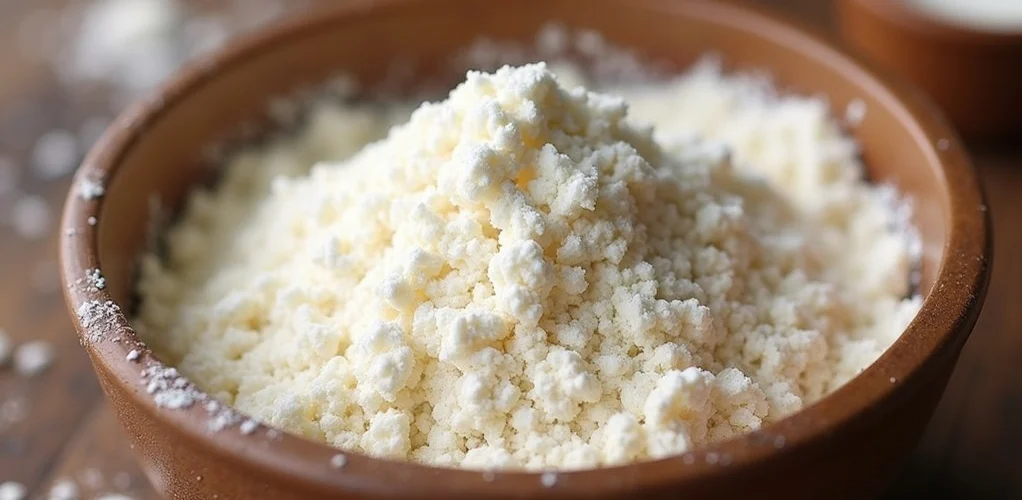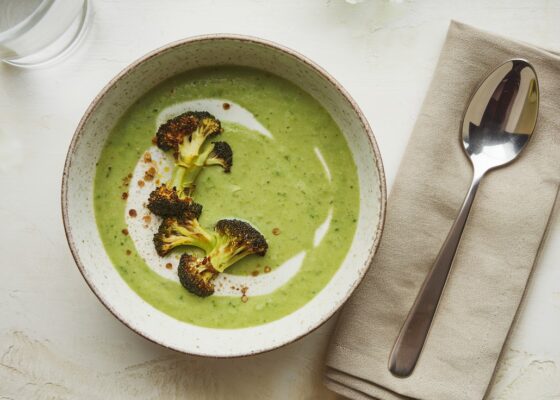
Tapioca flour is not low-carb, containing 90 grams of net carbohydrates per 100-gram serving and possessing a high glycemic index of 70. This gluten-free flour, derived from cassava root, can cause significant blood sugar spikes and quickly deplete daily carb allowances on ketogenic or low-carb diets. While it serves as a useful thickener and baking ingredient, health-conscious consumers should consider alternatives like almond flour or coconut flour, which offer superior nutritional profiles and fewer carbohydrates.
Key Takeaways
- Tapioca flour is high in carbohydrates, containing 90g of net carbs per 100g serving, making it unsuitable for low-carb diets.
- The glycemic index of tapioca flour is 70, causing rapid blood sugar spikes that can disrupt ketosis and glucose stability.
- A quarter-cup serving of tapioca flour contains 26g of carbohydrates, quickly depleting daily carb allowances on low-carb diets.
- Alternative low-carb flours like almond flour (10g net carbs) and coconut flour (21g net carbs) offer better options for low-carb baking.
- Despite being gluten-free, tapioca flour lacks essential nutrients and contains minimal protein, fat, and fiber compared to healthier flour alternatives.
What Is Tapioca Flour and Its Origins
A staple in global cuisine, Tapioca Flour emerges from the versatile cassava root, scientifically known as Manihot esculenta, which has sustained populations across South America for centuries.
This gluten-free flour is produced through an extensive process where the starchy liquid is extracted from ground cassava root and then carefully dried into a fine, powdery substance.
While tapioca flour has gained popularity as a thickening agent and flour substitute, particularly among those with dietary restrictions, it's important to note that it's high in carbohydrates and offers minimal nutritional value.
The flour contains negligible amounts of protein, fat, and fiber, making it primarily composed of starch.
Today, this versatile ingredient is widely used across Africa, Asia, and other regions where cassava cultivation has become integral to local food systems.
Nutritional Profile of Tapioca Flour
Understanding tapioca flour's nutritional composition reveals why this grain-free ingredient presents challenges for those following low-carb eating plans. With 26 grams of carbohydrates per quarter-cup serving, its nutritional profile primarily consists of starchy carbohydrates with minimal protein, fat, or fiber content.
| Nutrient | Amount per 100g |
|---|---|
| Calories | 350 |
| Net Carbs | 90g |
| Protein | <1g |
| Fat | 0g |
| Fiber | 0g |
For those monitoring their carbohydrate intake, tapioca flour's high in carbs nature makes it unsuitable for ketogenic or strict low-carb diets. With 90 net carbs per 100g serving, it's considered a source of empty calories. However, blending it with nutrient-dense alternatives like coconut or almond flour can help improve the overall nutritional value of baked goods.
Carbohydrate Content Analysis
Detailed analysis of tapioca flour's carbohydrate content reveals concerning implications for individuals following low-carb dietary protocols. With approximately 90 grams of net carbs per 100-gram serving, this flour contains a high amount of carbohydrates that can quickly deplete daily carb allowances on restricted eating plans like the keto diet.
A standard quarter-cup serving contains 26 grams of carbohydrates, which often exceeds the entire daily carb limit for those following strict low-carb diets.
The flour's high glycemic index of 70 compounds this issue, as it can trigger rapid blood sugar spikes upon consumption. When compared to keto-friendly alternatives such as almond or coconut flour, tapioca flour's carb content makes it an unsuitable choice for maintaining ketosis or achieving low-carb dietary goals. Individuals on the keto diet should prioritize high-quality fats to manage cholesterol levels effectively, which is a crucial aspect of maintaining heart health while following such dietary restrictions.
Impact on Blood Sugar and Ketosis
Tapioca flour's high glycemic index of 70 triggers rapid blood sugar elevation, creating significant challenges for individuals attempting to maintain stable glucose levels and ketosis. The substantial glycemic load, combined with its concentrated carbohydrate content, poses a direct threat to ketogenic states, potentially disrupting metabolic adaptations achieved through carb restriction. When compared to keto-friendly alternatives like almond or coconut flour, tapioca flour's impact on blood sugar and ketosis makes it a problematic choice for those following low-carb dietary protocols. The ketogenic diet greatly reduces blood glucose levels and stabilizes HbA1c, preventing harmful blood sugar spikes, which is crucial for those managing diabetes.
Blood Sugar Response Patterns
When considering blood sugar management, careful attention must be paid to the significant impact of tapioca flour on glucose levels and ketosis maintenance.
With a high glycemic index of 70, tapioca flour triggers rapid blood sugar spikes, making it particularly challenging for those monitoring their glucose levels. The substantial net carb content of 90g per 100g serving can quickly overwhelm daily carb limits, especially for individuals following ketogenic protocols.
Unlike more favorable alternatives containing resistant starches, tapioca flour's carbohydrate composition prompts a pronounced insulin response.
This metabolic reaction can disrupt blood sugar stability and compromise ketosis maintenance, as the body shifts from fat metabolism to glucose processing. Regular consumption may create ongoing challenges for those seeking to maintain stable blood sugar patterns or preserve ketogenic states.
Ketosis Disruption Risk Levels
Understanding the ketosis disruption risk levels associated with tapioca flour reveals considerable concerns for individuals following ketogenic protocols. With 90g of net carbs per 100g serving and a high glycemic index of 70, tapioca flour poses substantial risks for maintaining ketosis and stable blood sugar levels.
| Risk Factor | Impact Level |
|---|---|
| Carb Content | Very High |
| Glycemic Response | High |
| Ketosis Disruption | Severe |
| Blood Sugar Impact | Considerable |
| Daily Carb Limit | Exceeds |
The absence of fiber compounds these issues, as the rapid absorption of carbohydrates can quickly deplete daily carb allowances. For those committed to low carb lifestyles, alternatives like almond or coconut flour present considerably lower risks of disrupting ketosis while offering better nutritional profiles.
Glycemic Load Vs Alternatives
Comparing the glycemic impact of various flour alternatives reveals stark differences in their effects on blood sugar and ketosis maintenance.
Tapioca flour's high glycemic index of 70 and substantial net carbs (90g per 100g) make it particularly challenging for those following a keto diet, as it can trigger rapid blood sugar spikes and disrupt ketosis.
In contrast, low-carb alternatives like almond and coconut flour offer markedly better options for blood sugar management.
These alternatives not only contain fewer carbohydrates but also provide additional nutritional benefits through higher fiber content and essential nutrients.
For individuals committed to maintaining stable blood glucose levels while following a ketogenic lifestyle, choosing these alternative flours becomes vital for successful dietary adherence and metabolic stability.
Comparing Tapioca Flour to Other Low-Carb Flours
When comparing tapioca flour to popular low-carb alternatives, its 90g of net carbs per 100g serving stands in stark contrast to almond flour's mere 10g and coconut flour's 21g per serving. While tapioca flour offers a smooth, stretchy texture ideal for certain baking applications, low-carb alternatives like almond and coconut flour provide similar versatility with considerably fewer carbohydrates and additional nutritional benefits. It's important to note that starchy vegetables like potatoes and corn also contain high carb content, which can disrupt ketosis. The choice between these flours often depends on specific dietary needs and baking requirements, with tapioca flour being better suited for traditional baking, while almond and coconut flours excel in low-carb and keto-friendly recipes.
Carb Content Analysis
The carbohydrate profile of tapioca flour presents a significant challenge for those following low-carb dietary protocols, with its 90g of net carbs per 100g serving far exceeding the daily limits of most restricted-carb eating plans.
In conducting a carb content analysis, the stark contrast between tapioca flour and its alternatives becomes apparent. Almond flour emerges as a substantially more keto-friendly option, containing only 10g of net carbs per 100g, while coconut flour follows with 21g per 100g.
Flaxseed meal, with 29g of net carbs per 100g, provides another viable alternative for low-carb baking needs, offering the additional benefits of high fiber content and omega-3 fatty acids.
These comparisons clearly demonstrate why tapioca flour is generally avoided in low-carb meal planning.
Flour Texture Differences
Physical characteristics of different low-carb flour alternatives reveal distinct textural properties that greatly impact their baking performance and final results. When comparing tapioca flour to popular low-carb alternatives, significant differences emerge in their composition and handling characteristics.
| Flour Type | Texture | Absorbency |
|---|---|---|
| Tapioca | Fine, powdery | Moderate |
| Almond | Coarse, oily | Low |
| Coconut | Fine, dense | High |
| Flaxseed | Gritty, fibrous | Low |
| Cassava | Smooth, starchy | Moderate |
These textural variations directly influence baking outcomes, with tapioca flour providing a smooth, starchy consistency ideal for traditional recipes. However, low-carb alternatives like almond and coconut flour offer unique textures that require recipe adjustments but deliver superior nutritional profiles for carb-conscious baking.
Best Baking Applications
Despite its versatility as a thickening agent, tapioca flour proves problematic for low-carb baking applications due to its high carbohydrate content, especially when compared to more suitable alternatives like almond and coconut flour.
When selecting flours for low-carb baking, alternative flours offer considerably better options than tapioca starch. Almond flour, with only 10g of net carbs per 100g, performs well in cakes, cookies, and bread recipes.
Coconut flour, containing 23g of net carbs per 100g, excels in lighter baked goods and can be combined with other low-carb flours for ideal texture. Flaxseed meal, while higher in net carbs at 29g per 100g, adds nutritional benefits through its omega-3 content and works particularly well in heartier baked goods like muffins and bread.
Keto-Friendly Substitutes for Tapioca Flour
While tapioca flour remains a popular baking ingredient, individuals following a ketogenic diet can find excellent low-carb alternatives in almond flour, coconut flour, and flaxseed meal.
These keto-friendly substitutes offer considerably lower net carb content, with almond flour containing only 10-12g per 100g, making it an ideal choice for low-carb baking needs.
Coconut flour, with 21g net carbs per 100g, and flaxseed meal, containing 29g net carbs per 100g, provide additional options for keto bakers.
When substituting tapioca flour with these alternatives, it's essential to adjust liquid quantities due to their different absorption properties.
Combining these ingredients can create optimal textures while maintaining ketogenic requirements.
The nutritional benefits, particularly the omega-3 fatty acids in flaxseed meal, make these substitutes both practical and healthful choices.
Additionally, using high-fat dairy in recipes can enhance flavor and promote satiety, aligning with keto dietary goals.
Understanding Resistant Tapioca Starch
Beyond traditional keto-friendly flour substitutes, resistant tapioca starch offers a unique solution for low-carb bakers seeking specific functional properties in their recipes. This modified form of tapioca undergoes special processing that alters its digestibility, making it more compatible with low-carb diets while retaining useful baking characteristics.
| Property | Regular Tapioca | Resistant Starch |
|---|---|---|
| Digestibility | Fully digestible | Partially resistant |
| Net Carbs | High (90g/100g) | Lower impact |
| Gut Health | Minimal effect | Promotes prebiotics |
| Baking Use | Standard binding | Enhanced texture |
Resistant starch functions similarly to prebiotic fiber, supporting digestive health while improving gluten-free baking outcomes. Its ability to enhance moisture retention and texture makes it particularly valuable for those seeking to reduce carbohydrate intake without sacrificing quality in their baked goods.
Best Uses in Gluten-Free Baking
Tapioca flour's exceptional ability to control texture and crumb in gluten-free baking makes it a valuable ingredient for achieving the desired chewiness in cookies, breads, and pastries.
Its rapid absorption of liquids contributes greatly to moisture retention, helping prevent the common problem of dry, crumbly gluten-free baked goods.
When properly incorporated into recipes, tapioca flour creates a binding effect that mimics some of the structural properties of gluten, particularly when combined with other gluten-free flours for ideal results.
Texture and Crumb Control
When creating gluten-free baked goods, achieving the perfect texture and crumb structure presents a significant challenge that can be effectively addressed through the strategic use of tapioca flour.
This versatile ingredient's exceptional moisture-absorption properties contribute to the desired chewy texture while enhancing the overall elasticity of dough compositions. The flour's fine granulation promotes a lighter, airier crumb structure, particularly beneficial in items like pancakes and waffles.
When combined with other gluten-free flours, tapioca flour serves as a vital binding agent, improving structural integrity and creating a more appealing final product. Its unique gel-forming capabilities effectively mimic the functionality of traditional fats and additives, ensuring superior moisture retention and textural consistency throughout the baking process.
Moisture Retention Benefits
The remarkable moisture retention capabilities of tapioca flour stand at the forefront of its advantages in gluten-free baking applications. Its unique ability to absorb liquid up to twice its volume transforms it into a dough-like paste when heated, ensuring baked goods maintain ideal moisture levels throughout the baking process.
In gluten-free baking, where traditional binding agents are absent, tapioca flour proves versatile by enhancing both texture and structure. Its neutral flavor profile allows it to work seamlessly with other gluten-free flours while contributing to improved chewiness in the final product.
When incorporated into recipes, it effectively controls moisture distribution, resulting in better crumb texture and preventing the common dryness often associated with gluten-free baked goods.
Health Benefits and Drawbacks
Although widely used as a gluten-free alternative in baking, tapioca flour presents both significant benefits and notable drawbacks for health-conscious consumers. While it serves as an excellent binding agent for those avoiding gluten, its high carbohydrate content makes it unsuitable for low-carb diets, containing approximately 90g of net carbs per 100g serving. The flour's lack of essential nutrients raises concerns about potential deficiencies when used as a primary flour substitute. Its high glycemic index of 70 can trigger rapid blood sugar spikes, making it problematic for individuals monitoring their glucose levels. Additionally, some people may experience digestive issues when consuming excessive amounts. For ideal health outcomes, moderation is key when incorporating tapioca flour into recipes, particularly for those with specific dietary requirements or blood sugar concerns. Those following low-carb diets should be aware of nutrient deficiencies that can occur due to restrictive eating habits.
Recipe Modifications for Low-Carb Diets
Given the challenges of tapioca flour's high carbohydrate content, individuals following low-carb diets can successfully modify their recipes using strategic substitutions. When substituting tapioca flour, almond flour serves as an excellent low-carb alternative, offering considerably reduced carbohydrates while maintaining recipe functionality. For best results, combining different low-carb alternatives often yields the best texture and flavor profiles. Coconut flour, with its lower carb content and additional fiber, can be paired with almond flour in recipe modifications to achieve desired consistency. Flaxseed meal presents another viable option, introducing beneficial omega-3 fatty acids while keeping carbohydrates minimal. These alternatives not only support carb reduction goals but also enhance the nutritional value of baked goods, making them suitable for various low-carb dietary approaches. Vegetarian Keto merges vegetarianism with ketogenic principles, offering ways to enjoy diverse meals while maintaining low-carb intake.
Frequently Asked Questions
Is Tapioca Flour Good for a Low Carb Diet?
Tapioca flour is unsuitable for low carb diets due to its high carbohydrate content. While gluten free, better nutritional benefits can be found in low carb recipes using alternatives like almond or coconut flour.
Which Flour Has the Lowest Carbs?
Among low-carb alternatives, psyllium husk contains virtually zero net carbs, followed by almond flour with 10-12g per 100g, while coconut flour and flaxseed meal offer additional nutritional benefits despite higher counts.
Does Tapioca Flour Spike Blood Sugar?
Tapioca flour considerably impacts blood sugar levels due to its high glycemic index of 70. This rapid carbohydrate absorption raises health concerns for individuals monitoring glucose levels or managing diabetes.
Is Tapioca a Staple Food?
Tapioca serves as a global dietary staple, particularly in tropical regions. Despite limited nutritional benefits, its versatile culinary uses, affordability, and suitability for dietary restrictions make it culturally significant worldwide.
Conclusion
Tapioca flour, while valuable for gluten-free baking, is not suitable for low-carb diets due to its high carbohydrate content and glycemic impact. Those following ketogenic or low-carb lifestyles should opt for alternatives like almond flour, coconut flour, or psyllium husk. However, tapioca flour remains an excellent choice for individuals seeking gluten-free options without carbohydrate restrictions, offering versatility in baking and cooking applications.










No Comments